Variegated Pygmy Perch
Variegated Pygmy PerchNannoperca variegata | |
|---|---|
| Kingdom: | Animalia |
| Phylum: | Chordata |
| Class: | Actinopterygii |
| Order: | Perciformes |
| Family: | Percichthyidae |
| Status | |
| World: | Endangered (IUCN Red List 2025) |
| Australia: | Vulnerable (EPBC Act 1999) |
| Victoria: | Endangered (FFG Threatened List 2025) |
| FFG: | Listed Action Statement No. 15 |
| Profiles | |
| Australia: | Atlas of Living Australia |
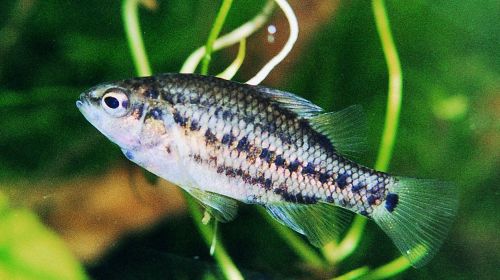
The Variegated Pygmy Perch is one of the less seen but very beautiful native freshwater fish of Australia. It only occurs in the Glenelg River system in south-west Victoria and a small number of sites east of Port Macdonnell in south-eastern South Australia.
The Variegated Pygmy Perch is one of the Percichthyidae or temperate perch family and is related to a small group of fishes referred to as Pygmy Perch (more recently considered to be within their own family Nannopercidae). This species was only recognised in 1986 and formerly known as Ewens Pygmy Perch due to its presence in Ewens Ponds in South Australia (Kuiter & Allen 1986).
Four species of Pygmy Perch occur in Victoria, Conservation status (DSE 2013) and current conservation status (FFG Threatened List 2025).
- Variegated Pygmy Perch Nannoperca variegata (vulnerable), Endangered
- Southern Pygmy Perch Nannoperca australis (common except Upper Murray River to Avoca River where it is vulnerable), Vulnerable
- Yarra Pygmy Perch Nannoperca obscura, previously referred to as Edelia obscura (vulnerable), Vulnerable
- Flinders Pygmy Perch Nannoperca sp. 1 (not know in 2013), Vulnerable
All Pygmy Perches are small oblong shape fish having one dorsal fin with a deep notch and the lateral line divided into two parts. Detailed identification between species of Pygmy Perch include among other features, the counting of dorsal spines and pectoral rays which is elaborated in Kuiter et al. (1996).
The Variegated Pygmy Perch grows to about 60mm, colouring can vary from shades of green to dark brown above, to light brown and gold/yellow on the sides grading to a whitish or orange belly, it usually has a dark spot on the base of the caudal fin, and a series of dark spots that form two broken horizontal lines.
Distribution
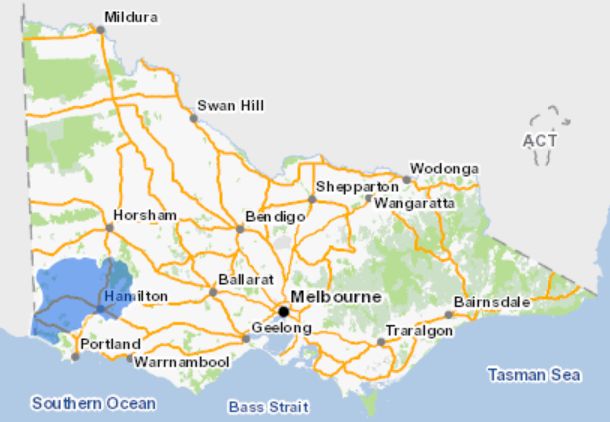
Known distribution of Variegated Pygmy Perch in Victoria (Glenelg River Catchment). Source: VBA 2025.
In Victoria, the Variegated Pygmy Perch is only found in the Glenelg River system, encompassing the Glenelg, Crawford and Wannon River catchments where a total of 13 sites have been recorded.
Other populations of Variegated Pygmy Perch occur approximately 25 km west of the Victorian populations in south-east South Australia where they are found in Karst Rising Spring systems; Deep Creek (including Stratmans Pond) and Eight Mile Creek (including Ewens Ponds). (Veale pers. comms. 2017, ALA 2017, Allen 1989a).
Habitat and ecology
Variegated Pygmy Perch inhabit relatively shallow freshwater streams with a bias to sites with high levels of healthy aquatic vegetation, low levels of siltation and low salinity (660-2810 mg/L). Unlike the habitat preference for other Pygmy Perch it is found in areas with moderate to high water flow. Because the known populations are quite fragmented it is likely that remaining stocks are genetically discrete (Hammer 2000).
Studies in south-east South Australia found Variegated Pygmy Perch have a protracted spawning season from winter (August) to summer (December) (Veale & Whiterod (2017). Eggs are attached to aquatic vegetation.
Threats
Remaining populations of Variegated Pigmy Perch are now confined to only a small percentage of what may have been its former range, this indicates that significant levels of environmental stress have already been placed on this species. Threats to remaining populations are similar to those faced by many species of native freshwater fish, however in the case of Variegated Pygmy Perch threats are magnified due to fragmented populations and increased risk of loss should environmental conditions deteriorate.
Altered flow regimes
- Extraction of water (directly from streams and from groundwater which has interconnection with surface flows). This can result in degraded conditions, particularly during seasonal low flow events.
- Drainage of wetlands which increases peak flow over a short duration and deprive a sustained contribution to longer duration base flow.
Damage to aquatic habitats
- Direct disturbance to instream environment caused by channelization, desnagging and instream works.
- Siltation from soil erosion, poor timber harvesting practices, unmaintained vehicle tracks and stock access to stream bank and bed.
- Pollution of water from herbicides and other chemicals, nutrient enrichment from fertilisers and agricultural run off.
- Degraded riparian zone through clearing, stock access, rabbits and introduced riparian flora.
Competition and predation from introduced species
- Displacement of Pygmy Perch by established introduced species such as Carp and Redfin which are capable of self sustaining populations (ie. the Glenelg and Crawford River contain self-supporting populations of Redfin which are a predator of Pygmy Perch).
- Increased spread and establishment of species such as Gambusia, which can opportunistically become established when aquatic environments become degraded and conditions no longer favour the Variegated Pygmy Perch.
- Inappropriate stocking of species such as Rainbow Trout and Brown Trout which are predator species.
- Escape from aquaculture eg. movement of Golden Perch from farm dams into the catchment, where they subsequently become predators of Variegated Pygmy Perch.
Barrier to fish movement
- Physical barriers such as weirs, and stream segmentation in periods of reduced water flow which may prevent movement associated with spawning and feeding.
Genetic isolation
- Possible decline within populations due to fragmentation into discrete stocks and low likelihood of genetic variability.
The unseen cumulative effect
Whilst any one of the above threats is capable of impacting on the Variegated Pygmy Perch, it can be difficult to gauge the level of impact on such a cryptic species. This may result in underestimating the level of a singular threat and complacency in regard to how the cumulative impact reaches a point where the species can no longer survive. It is therefore extremely important to consider the whole range of threats and how these combine to influence the viability of Variegated Pygmy Perch in our waterways.
Conservation of Variegated Pygmy Perch
The conservation status of Variegated Pygmy Perch was re-assessed from Vulnerable in 2013 (DSE 2013) to Endangered in 2020 as part of the Conservation Status Assessment Project – Victoria (DELWP 2020).
The Glenelg Hopkins Catchment Management Authority (GHCMA) has taken a lead role in protecting and enhancing known populations through improved habitat management and restoration conditions which support this species.
The Glenelg Hopkins Waterway Strategy 2014-2022 identifies several rivers and steam reaches which are subject to management specifically tailored to help Variegated Pygmy Perch.
Part D of the Strategy
08 - Protect all known populations of variegated pygmy perch and take immediate action to ensure that suitable habitat is appropriately management in at least three locations
- Lower Glenelg Crawford River Identification No: 38-15
- Stokes River Identification No: 38-20
- Upper Glenelg River Identification No: 38-06, 38-08, 38-09
- Upper Glenelg – Wando River Identification No: 38-44
- Wannon river - Identification No: 38-22, 38-24, 38-26, : 38-30
- Grange Burn Creek - Identification No: 38-35, 38-37
The type of management activities includes where approprite to each priority location:
- Ensure that forestry best management practice is implemented in relevant catchments for sediment management.
- Licensed sand and gravel extraction.
- Install riparian fencing in relevant areas.
- Establish native indigenous vegetation.
- Establish inland aquatic pest control (carp) in areas identified.
- Ensure that best management practice for grazing is implemented in the relevant catchment.
- Establish terrestrial pest animal control at waterway as part of a cooperative regional partnership program.
- Participate in bulk entitlement, licensing and management rule review process.
- Deliver environmental water to reach in line with Seasonal Watering Plan.
- Modify fishway (Wannon).
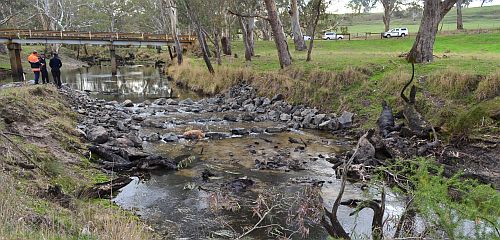
Additional conservation measures
Survey and monitoring
Surveys have been an ongoing program which has been conducted through GHCMA and the Arthur Rylah Institute which has significantly increased information about populations of Variegated Pygmy Perch and their health.
As well as sections of the Glenelg River, Crawford River, Wannon River, Glenaulin Creek and Stokes River other survey waterways include:
- Grange Burn Creek
- Little Glenaulin Creek
- Macpherson Creek
- Marino Creek
- Mcrae Creek
- *Miakite Creek
- Salt Creek
- Wennicott Creek
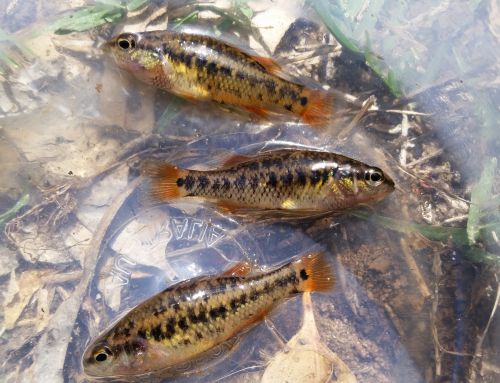
Stocking
Fisheries Victoria to liaise with local angling groups to ensure predation by Trout and other non-indigenous fish is understood as an issue of concern and that this be taken into account in when considering stocking.
Further research
Determine whether crayfish collecting activities are damaging Variegated Pygmy Perch habitat.
Reassess fire protection activities in the catchment to ensure harvesting or burning programs do not have a negative impact on the habitat of this species.
Forestry operations: Continue to plan softwood and hardwood logging activities in accordance with the Forest Code of Practice to avoid threats to fish populations
Establish an Environmental Overlay in Municipal Planning Schemes to prevent inappropriate development or work in the sub-catchment which support Variegated Pygmy Perch.
Conservation achievements
The Glenelg Hopkins Waterway Strategy 2014-2022 builds on the old Glenelg-Hopkins River Health Strategy Overview 2004-2009. This document included several areas relevant to Variegated Pygmy Perch conservation. Mid Glenelg G3, G8, Crawford River, Glenaulin Creek, and the mainstem of the Glenelg River. Lower Wannan G9 and Grange Burn G13 sub-catchments as being important stream reaches for conservation of the Variegated Pygmy Perch. A significant amount of work has been undertaken in these priority area by the GHCMA, community groups, landholders and the timber plantation industry.
Glenelg River Restoration Project
This project commenced in 2000 and has involved, fencing and revegetation, estuary management, urban waterway restoration, wood re-instatement, construction of erosion control structures, the establishment of environmental flow releases, sand extraction, carp monitoring and eradication, weed control and the removal of fish barriers.
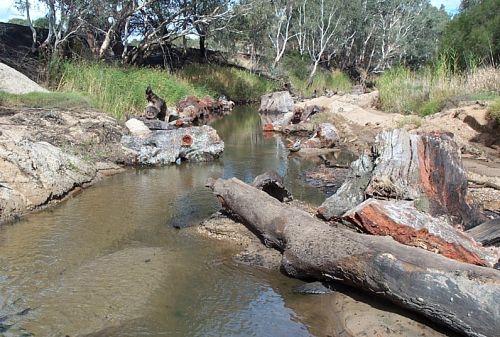
Importantly there has been 150% increase in Variegated Pygmy Perch in the Glenelg system. GHCMA (Glenelg River Restoration project).
Livestock have been excluded from over 50% of the Crawford River waterway frontage.
Three barriers to fish passage on the lower Crawford River have been removed.
Species conservation status in Victoria changed from endangered in 2003 to vulnerable in 2013 (DSE 2003 & DSE 2013).
Environmental flows
Environmental flows from Rocklands Reservoir have played an important role in increasing connectivity and maintaining habitat availability for Variegated Pygmy Perch in the Glenelg River since 2011. These conditions have allowed populations to recover, increasing in their abundance and spatial distribution in the Glenelg River.
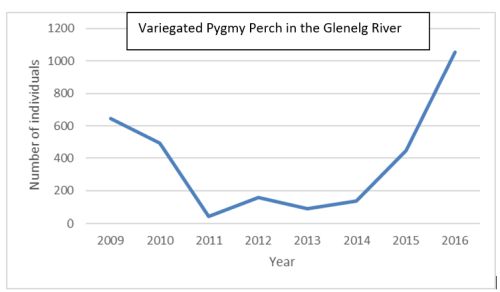
It should be noted the population decrease from 2009-2011 was most likely caused by drought conditions which reduced the river to a chain of pools. During this time, there was no evidence of recruitment recorded.
Management partnerships
Landcare Groups in the Lower Glenelg G2 sub-catchment include the Baghalla-Killara and the Sandford Landcare Groups.
Landcare Groups in the Mid Glenelg G3 sub-catchment include the Chetwynd, Red cap-Dergholm, Dunrobin, Wando River and Baghallah-Killara Landcare Groups.
The Stokes River G8 sub-catchment contains the Rifle Downs Landcare Group, Miakite-Grassdale Tree Group and the Smokey River Land Management Group (GHCMA 2004).
Management partnerships between Greening Australia the Glenelg Hopkins CMA and timber plantation companies have been established and resulted in positive on-ground restoration works that benefit Variegated Pygmy Perch.
Hancock Victorian Plantation P/L have pulled back pine plantations from the creek frontage of Glenaulin Creek, effectively creating streamside reserves and carrying out revegetation of riparian zones. Over 8000 trees have been planted adjacent to the creek which has resulted in improvements to streamside protection and instream habitat for the Variegated Pygmy Perch.
Greening Australia have also had some significant projects along the Crawford River in partnership with Integrated Tree Cropping Ltd., regarding revegetation of the Kangaroo Creek and other sites in the upper Crawford River. Removal of stock from instream and streamside habitat combined with strategic revegetation to complement remnant vegetation and wetlands will assist in enhancing water quality and habitat for the Variegated Pygmy Perch.
Tree Corp Ltd has also undertaken revegetation works on Crawford River.
References
DELWP (2020) Provisional re-assessments of taxa as part of the Conservation Status Assessment Project – Victoria 2020, Department of Environment Land Water and Planning, Victoria. Conservation Status Assessment Project – Victoria
DSE (2013) Advisory List of Threatened Vertebrate Fauna in Victoria – 2013. Department of Sustainability & Environment, Victoria, East Melbourne, Victoria.
Fisher, J (1993), Flora and Fauna Guarantee Action Statement No.42, Variegated Pygmy Perch, Department of Sustainability & Environment, East Melbourne, Victoria.
GHCMA (2004) Glenelg Hopkins River Health Strategy, Glenelg Hopkins Catchment Management Authority [http://www.glenelg-Hopkins.vic.gov.au/aboutus/publications.asp GHCMA publications inc. River Health Strategy]
Glenelg Hopkins Waterway Strategy 2014-2022
Hammer M. (2000) Conservation of the Variegated Pygmy Perch, Freshwater Fish Survey of the Lower South Eastern South Australia, Supported by National Parks and Wildlife SA and South Eastern Water Conservation and Drainage Board, November 2000.*Hammer M (2001) Freshwater Fishes of South Eastern South Australia, Data Sheet, Native Fish Australia (S.A.) Inc.
IUCN (2025) Whiterod, N., Raadik, T. & Hammer, M. 2019. Nannoperca variegata. The IUCN Red List of Threatened Species 2019: https://dx.doi.org/10.2305/IUCN.UK.2019-3.RLTS.T14322A123378462.en. Accessed on 29 April 2025.
Koehn, J.D. & Morison, A.K. (1990) A review of the conservation status of native freshwater fish in Victoria. Victorian Naturalist 170 (1), 13-25.
Kuiter, R.H. & Allen, G.R. (1986) A synopsis of the Australian Pygmy Perches (Percichthyidae), with the description of a new species. Review fr. Aquariol., 12, pp 109-116 (1985).
Kuiter, R.H., Humpheries, P., Arthington, A.H. (1996) Pygmy Perch. In; Freshwater Fishes of South-Eastern Australia, Ed. McDowall, R.M., pp168-175. Reed Books: Sydney.
NFA SA (2009) Action Plan for South Australian Freshwater Fishes, Native Fish Australia (SA). See Conservation status of threatened species - Department of Environment, Water & Natural Resources, South Australia.
Saddlier, S, and Hammer, M. (2010) National Recovery Plan for the Variegated Pygmy Perch Nannoperca variegata 2010. Department of Sustainability and Environment, Melbourne. Accessed from Australian Government Department of Environment & Energy.
VBA (2025) Victorian Biodiversity Atlas, Department of Energy, Environment and Climate Action, Victoria (DEECA).
Veale pers. comms. (2017) Dr Lauren Veale, Aquatic Ecologist, Nature Glenelg Trust.
Veale, L. & Whiterod, N. (2017). Aquatic threatened species monitoring of Karst Rising Springs: 2014‒2017. Report to the Department of Environment, Water and Natural Resources, Government of South Australia. Nature Glenelg Trust, Mount Gambier, South Australia.
See also:
- Glenelg River Restoration project Glenelg Hopkins CMA
- Monitoring Variegated Pygmy Perch in south-east South Australia Nature Glenelg Trust

